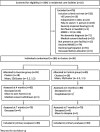Effects of a High-Intensity Functional Exercise Program on Dependence in Activities of Daily Living and Balance in Older Adults with Dementia
- PMID: 26782852
- PMCID: PMC4722852
- DOI: 10.1111/jgs.13880
Effects of a High-Intensity Functional Exercise Program on Dependence in Activities of Daily Living and Balance in Older Adults with Dementia
Abstract
Objectives: To investigate the effects of a high-intensity functional exercise program on independence in activities of daily living (ADLs) and balance in older people with dementia and whether exercise effects differed between dementia types.
Design: Cluster-randomized controlled trial: Umeå Dementia and Exercise (UMDEX) study.
Setting: Residential care facilities, Umeå, Sweden.
Participants: Individuals aged 65 and older with a dementia diagnosis, a Mini-Mental State Examination score of 10 or greater, and dependence in ADLs (N=186).
Intervention: Ninety-three participants each were allocated to the high-intensity functional exercise program, comprising lower limb strength and balance exercises, and 93 to a seated control activity.
Measurements: Blinded assessors measured ADL independence using the Functional Independence Measure (FIM) and Barthel Index (BI) and balance using the Berg Balance Scale (BBS) at baseline and 4 (directly after intervention completion) and 7 months.
Results: Linear mixed models showed no between-group effect on ADL independence at 4 (FIM=1.3, 95% confidence interval (CI)=-1.6-4.3; BI=0.6, 95% CI=-0.2-1.4) or 7 (FIM=0.8, 95% CI=-2.2-3.8; BI=0.6, 95% CI=-0.3-1.4) months. A significant between-group effect on balance favoring exercise was observed at 4 months (BBS=4.2, 95% CI=1.8-6.6). In interaction analyses, exercise effects differed significantly between dementia types. Positive between-group exercise effects were found in participants with non-Alzheimer's dementia according to the FIM at 7 months and BI and BBS at 4 and 7 months.
Conclusion: In older people with mild to moderate dementia living in residential care facilities, a 4-month high-intensity functional exercise program appears to slow decline in ADL independence and improve balance, albeit only in participants with non-Alzheimer's dementia.
Keywords: activities of daily living; dementia; exercise; postural balance; residential facilities.
© 2016 The Authors. The Journal of the American Geriatrics Society published by Wiley Periodicals, Inc. on behalf of The American Geriatrics Society.
Figures


References
-
- World Health Organization. Dementia: A Public Health Priority [on-line]. Available at http://www.who.int/mental_health/publications/dementia_report_2012 Accessed September 14, 2014.
-
- Allan LM, Ballard CG, Burn DJ, et al. Prevalence and severity of gait disorders in Alzheimer's and non-Alzheimer's dementias. J Am Geriatr Soc. 2005;53:1681–1687. - PubMed
-
- Morgan D, Funk M, Crossley M, et al. The potential of gait analysis to contribute to differential diagnosis of early stage dementia: Current research and future directions. Can J Aging. 2007;26:19–32. - PubMed
-
- Pettersson AF, Olsson E, Wahlund LO. Motor function in subjects with mild cognitive impairment and early Alzheimer's disease. Dement Geriatr Cogn Disord. 2005;19:299–304. - PubMed
-
- Sherrington C, Whitney JC, Lord SR, et al. Effective exercise for the prevention of falls: A systematic review and meta-analysis. J Am Geriatr Soc. 2008;56:2234–2243. - PubMed
Publication types
MeSH terms
LinkOut - more resources
Full Text Sources
Other Literature Sources
Medical
Molecular Biology Databases

